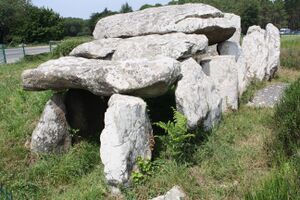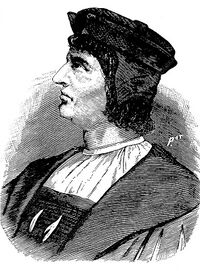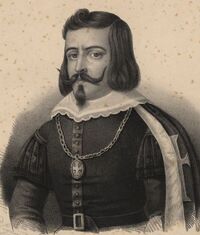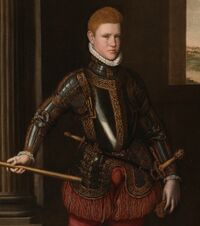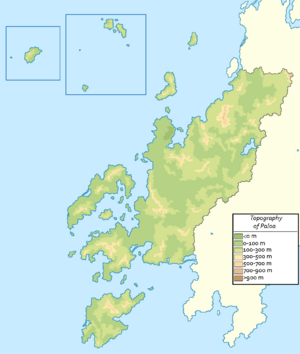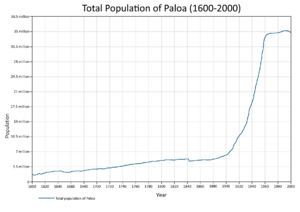Paloa: Difference between revisions
Philimania (talk | contribs) |
Philimania (talk | contribs) mNo edit summary |
||
| Line 58: | Line 58: | ||
|established_date3 = 23 Hunyo 1555 | |established_date3 = 23 Hunyo 1555 | ||
|established_event4 = [[War of Palon Succession]] | |established_event4 = [[War of Palon Succession]] | ||
|established_date4 = 26 Pulungana | |established_date4 = 26 Pulungana 1823-9 Kunnen 1825 | ||
|established_event5 = [[Peninsular War]] | |established_event5 = [[Peninsular War]] | ||
|established_date5 = | |established_date5 = 22 Okjatab 1828-17 Tebax 1830 | ||
|established_event6 = [[Enero 1957 Revolution|Republic]] | |established_event6 = [[Enero 1957 Revolution|Republic]] | ||
|established_date6 = 31 Enero 1957 | |established_date6 = 31 Enero 1957 | ||
| Line 123: | Line 123: | ||
[[File:Santo Vaz dolmen.jpg|thumb|left|The [[Santo Vaz dolmen]] near [[Santo Vaz]], built around the 4th millennium BCE.]] | [[File:Santo Vaz dolmen.jpg|thumb|left|The [[Santo Vaz dolmen]] near [[Santo Vaz]], built around the 4th millennium BCE.]] | ||
The region of what is now Paloa was settled by [[Dordon]] tribes, giving origin to peoples such as the [[Veragon people|Veragons]] and X which eventually evolved into the modern [[Palon people]]. Present-day Paloa was inhabited by ''[[Homo rectus]]'' before they went extinct around 300,000–30,000 BP and then by ''[[Homo validus]]'' and ''[[Homo captiosus]]'', both species roaming the border-less region of the [[Hesterlon Peninsula]] until the extinction of the ''Homo validus'' c. 7,000–6,000 BCE after which ''Homo captiosus'' remained. These were subsistence societies and although they did not establish prosperous settlements, they did form organized societies. Paloa during the [[Novalithic Age|Novalithic]] experimented with domestication of herding animals, the raising of some cereal crops and fluvial or marine fishing. {{wp|Metallurgy}} later appeared during the middle of the 3rd millennium BCE. Paloa, like its neighbours [[Cavala]] and | The region of what is now Paloa was settled by [[Dordon]] tribes, giving origin to peoples such as the [[Veragon people|Veragons]] and X which eventually evolved into the modern [[Palon people]]. Present-day Paloa was inhabited by ''[[Homo rectus]]'' before they went extinct around 300,000–30,000 BP and then by ''[[Homo validus]]'' and ''[[Homo captiosus]]'', both species roaming the border-less region of the [[Hesterlon Peninsula]] until the extinction of the ''Homo validus'' c. 7,000–6,000 BCE after which ''Homo captiosus'' remained. These were subsistence societies and although they did not establish prosperous settlements, they did form organized societies. Paloa during the [[Novalithic Age|Novalithic]] experimented with domestication of herding animals, the raising of some cereal crops and fluvial or marine fishing. {{wp|Metallurgy}} later appeared during the middle of the 3rd millennium BCE. Paloa, like its neighbours [[Cavala]] and [[Paqueonia]], possesses numerous {{wp|Megalith|megalithic}} sites with 435 known sites as of 2000, some well knowns of which are the [[Castro stones]] near present day [[Pinta]], and the [[Santo Vaz dolmen]] near [[Santo Vaz]]. | ||
=== Ancient and Antiquity Era === | === Ancient and Antiquity Era === | ||
Revision as of 03:46, 11 July 2022
This article is a work in progress. Any information here may not be final as changes are often made to make way for improvements or expansion of lore-wise information about Gentu. Please comment on this article's talk page to share your input, comments and questions. Note: To contribute to this article, contact User:Philimania. |
Republic of Paloa República de Paloa (Palon) | |||||||||
|---|---|---|---|---|---|---|---|---|---|
| Motto: Vivemos livres ("We live free") | |||||||||
| Anthem: X | |||||||||
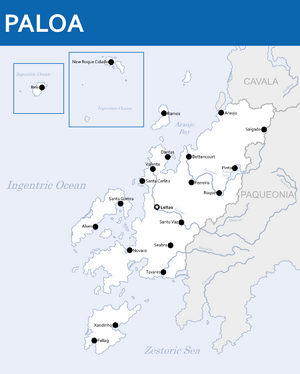 Map of Paloa | |||||||||
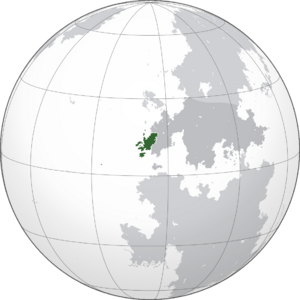 Location of Paloa (Green) in Oranland (Dark Grey) | |||||||||
| Capital | Leitao | ||||||||
| Largest city | Araujo | ||||||||
| Official languages | Palon | ||||||||
| Recognised regional languages | Hestandan | ||||||||
| Ethnic groups (2000) | |||||||||
| Religion (1999) |
| ||||||||
| Demonym(s) | Palon | ||||||||
| Government | Unitary semi-presidential republic | ||||||||
| Filipa Maciel | |||||||||
| Sebastião Rebelo | |||||||||
| Legislature | Congress of Paloa | ||||||||
| Assento | |||||||||
| Baixo Assembly | |||||||||
| History | |||||||||
| c. 100 BCE | |||||||||
| 12 Tebax 1102-3 Pusper 1105 | |||||||||
| 23 Hunyo 1555 | |||||||||
| 26 Pulungana 1823-9 Kunnen 1825 | |||||||||
| 22 Okjatab 1828-17 Tebax 1830 | |||||||||
• Republic | 31 Enero 1957 | ||||||||
| 22 Enero 1960 | |||||||||
| Area | |||||||||
• Total | 360,087.9 km2 (139,030.7 sq mi) (X) | ||||||||
• Water (%) | 0.4 | ||||||||
| Population | |||||||||
• 1997 estimate | |||||||||
• 1999 census | |||||||||
• Density | 96.9/km2 (251.0/sq mi) (X) | ||||||||
| GDP (PPP) | 1999 estimate | ||||||||
• Total | |||||||||
• Per capita | |||||||||
| GDP (nominal) | 2000 estimate | ||||||||
• Total | |||||||||
• Per capita | |||||||||
| Gini (2000) | low (X) | ||||||||
| HDI (1999) | very high (X) | ||||||||
| Currency | Palon Ober (PØ) (PLO) | ||||||||
| Time zone | MTS-9 (West Oranland Time) MTS-11 (East Ingentric Time) MTS-12 (New Roque Time) | ||||||||
| Date format | dd-mm-yyyy | ||||||||
| Driving side | right | ||||||||
| Calling code | X | ||||||||
| Internet TLD | .pl | ||||||||
| |||||||||
Paloa, officially the Republic of Paloa (Palon: República de Paloa), is a country whose mainland is located on the Hesterlon Peninsula in western Oranland, and whose territory also include the New Roque archipelago and the island of Farata. Paloa is bordered by Paqueonia to the east, Cavala to the north, the Ingentric Ocean to the west, and the Zestoric Sea to the south. Leitao is the capital city of Paloa while Araujo is the largest city.
Paloa was inhabited by Homo rectus before they went extinct around 300,000–30,000 BP. Paloa during the Novalithic experimented with domestication of animals and cereal crops. Metallurgy later appeared during the middle of the 3rd millennium BCE. The Calidum Empire first settled in Paloa some time around 1300 BCE. They were expelled from the region around the 11th century BCE by the Veragon tribes. There were other related tribes such as the Farovans, Cyconts and Aeroans. Paloa was a relatively isolated region until the late 4th century BCE when the Pylosan Empire colonized the region. Several works of engineering, such as baths, temples, bridges, roads, circuses, theatres and laymen's homes are preserved throughout the country. In the early 6th century, the Palon people formed numerous kingdoms in modern day Paloa most notable being the Kingdom of Norab. Settlements such as Laton (Leitao) and Seabra was founded. At its height in 608, the kingdom occupied a territory of about 540,000 km2 (208,495 sq mi). In 776, the Dardonan Empire invade Paloa. The Pallas Council set up by the empire sponsored works of architecture such as the Estrutura de Belas Artes. In 1102, the Palon Revolution occured allowing Paloa to break away from Dardona.
From 1140 to 1164 and again from 1178 to 1204, Paloa was devastated by the Great Plague. A famine swept across the region resulting in the starvation of about 0.3 million people. The Terranist Genocide in Paloa saw the deaths and percecution of an estimated 200,000 to 600,000 Terranists. The enbarck was invented in 1505 by Palon engineer Quim Vaza which led to the discovery of the Domicas by Paqueon explorer Kuno Schenck in 1513. In 1522, Farata as well as New Roque were discovered and colonised. On the 23 Hunyo 1555, the Palon Empire was formed after the Mudon Charter was signed. In 1561, the Poder War erupted in South Domica, dividing the continent. A conflict in 1572 against the Neragese known as the Coffee War saw the expulsion of the Neragese East Naphtora Company. On 7 Phupu 1582, a skirmish occurred on the colonial border of Paqueonia and the Omaran Empire, starting the Flonesian War. It ended in 1586 with the expulsion of Paloa from the island of Aralona. During the Great Enlightenment, Paloa was considered one of Oranland's "unenlightened" backwaters. Márico Machado de Seabra reformed the education system in 1593 and demarcated the region for production of wine, the first attempt to control wine quality. The War of 1602 was fought between the Paqueon and Neragese Empire. Paloa joined the conflict nearing the end of the war in 1613.
- History
Palon has left a profound cultural, architectural and linguistic influence across the globe, with a legacy of around X Palon speakers around the world. It is a developed country with an advanced economy and high living standards. Additionally, it ranks highly in peacefulness, democracy, freedom, stability, social progress, and prosperity. A member of the Union of Realms, and the Oranland Trade Union, Palon was also one of the founding members of ARDO, and the Community of Palon Language Countries.
History
Prehistorical Paloa
The region of what is now Paloa was settled by Dordon tribes, giving origin to peoples such as the Veragons and X which eventually evolved into the modern Palon people. Present-day Paloa was inhabited by Homo rectus before they went extinct around 300,000–30,000 BP and then by Homo validus and Homo captiosus, both species roaming the border-less region of the Hesterlon Peninsula until the extinction of the Homo validus c. 7,000–6,000 BCE after which Homo captiosus remained. These were subsistence societies and although they did not establish prosperous settlements, they did form organized societies. Paloa during the Novalithic experimented with domestication of herding animals, the raising of some cereal crops and fluvial or marine fishing. Metallurgy later appeared during the middle of the 3rd millennium BCE. Paloa, like its neighbours Cavala and Paqueonia, possesses numerous megalithic sites with 435 known sites as of 2000, some well knowns of which are the Castro stones near present day Pinta, and the Santo Vaz dolmen near Santo Vaz.
Ancient and Antiquity Era
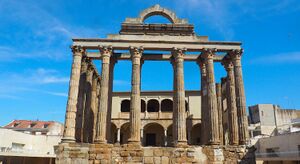
Based on the Calidum chronicles about the Veragon peoples and the interpretation of the abundant archaeological remains throughout the southern and central half of Paloa and some of X in X during the Ancient Era, it is possible to infer that there was a matriarchal society, with a religious aristocracy. The figures of maximum authority were the chieftain, of military type and with authority in his tribe, and the druid, mainly referring to medical and religious functions that could be common to several tribes. The first documentary references to tribal society in Paloa are provided by chroniclers of Calidum military campaigns such as Apui, Stephinates and X among others, about the social organization, and describing the inhabitants of these territories, the Veragese tribes of southern Paloa, also known as the Amossan are described as: "A group of barbarians who spend the day fighting and the night eating, drinking and dancing under the moon". There were other similar tribes and subgroups, chief among them were the Boromans; the core area of these people lay in central Paloa, while numerous other related tribes existed such as the Farovans, Cyconts and Aeroans.
The Calidum Empire first settled in Paloa some time around 1300 BCE. However, they were expelled from the region around the 11th century BCE by the Veragon tribes. Beginning from the 11th century BCE, the region would stay relatively isolated from the rest of the Zestoric until the late 4th century BCE when the Pylosan Empire colonized the region resulting in the founding of several cities that still remains to this day such as Tahu (Tavares), Nun-oni (Novaro), and Donkor (Dantas).
After the 2nd Zestoric War in 1 CE, Pylosan colonies including those in Paloa were assimilated into the Alarican Empire. However, Alarican control over the region suffered a setback in 3 CE when a rebellion began in the south. The Farovans and remnants of the Pylosan army under the leadership of Glycon, a former Pylosan general, fought for control over the southern Hesterlon Peninsula. Alarico sent numerous legions and its best generals to Paloa to quell the rebellion, in 10 CE, Glycon was killed in battle near Tavares resulting in a power struggle among Glycon's allies allowing Alarico to put an end to the rebellion in 11 CE.
In 129, Alarico conquered the rest of the Hesterlon Peninsula, installing a colonial regime over the region. Several works of engineering, such as baths, temples, bridges, roads, circuses, theatres and laymen's homes are preserved throughout the country. Coins, as well as numerous pieces of ceramics, were also found. Contemporary historians include Caninius (c. 360–422) and Oppius (c. 417–481), who detailed the final years of Alarican control over Paloa and the rebellions and uprisings led by the Palon people.
Palon kingdoms, Dardonan Empire, and revolution
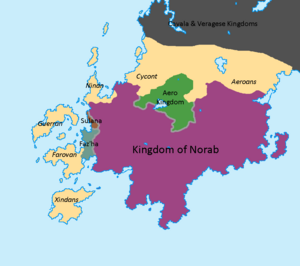
In the early 6th century, the Palon people formed numerous kingdoms in modern day Paloa. The Kingdom of Norab was the post-Alarican kingdom, established in what is now Santo Vaz and one of the largest in the region. Settlements such as Laton (Leitao) and Seabra was founded during this time period.
About during the 6th century it formally became the Kingdom of Norab, when king Romeric made a peace treaty with the Cyconts to the north establishing his control over the region. In 563 Romeric died, leaving the state to be divided by Romeric's two sons, with Alfredo and Filipe ruling simultaneously. Both reigned from 563 to 585, the year in which Parauno reunified the kingdom. From 589, he attempted to unite the Hesterlon Peninsula until his death in 614 after which the kingdom dissolved to numerous kingdoms and city-states. At its height in 608, Parauno's kingdom occupied a territory of about 540,000 km2 (208,495 sq mi).
In 766, the Dardonan Empire invaded the Hesterlon Peninsula from Alarico. An army of roughly 9,000 men led by Alexius I landed on the southern coast near Tavares. He won the Battle of Tahu against Joham, ruler of the Kingdom of Aavalo, securing a Darodan beachhead on the peninsula. By 769, Alexius conquered the southern and eastern coast and controlled most territory south of the Leitao River. However, he sustained severe injuries during the Battle of Laton in Memesa of 770 after which he died. His son Marcian II took his father's role as ruler in Marto the same year. The Battle of Aroun in 774 marked the end of the Darodan conquest of the Hesterlon Peninsula which saw the death of Alvoro, the leader of the last Palon kingdom. In 778, the Hesterlon Peninsula was fully intergrated into the empire as three provinces: Hestanda, Pallas, and Xamida.
Early Palon architecture appeared during this period of Palon history. The Pallas Council also sponsored works of architecture such as the Estrutura de Belas Artes (literally, the Structure of Fine Art) and led to the creation of the Pallaic style of achitecture in the 11th century. The Casa de Lã is the oldest known structure built of this architectural style in the early 9th century.
In 1059, the Hestando people rebelled against the Dardonans followed by numerous other movements most of which failed. Inspired by these uprisings and revolts, Tristico de Vasa, the mayor of Santa Vaz led a revolution against the Dardonans in 1102 known as the Palon Revolution. Tristico would be executed in 1104 after being captured at the Battle of Cume in Gunyana the same year. However the revolution was successful resulting in 1105 with the emergence of the Kingdom of Paloa under Nicolau I, a friend and successor of Tristico who also served as a general during the revolution.
Pre-Imperial Era

From 1140 to 1164 and again from 1178 to 1204, Paloa, like the rest of Oranland, was devastated by the Great Plague, with victims ranging from 0.4 to 1.5 million. During the time of the plague; around 1142, the trend of the Mutamni Purge spreaded to the region from Cavala. From 1142 to 1210, about 300,000 Mutamniers were condemned resulting in the near extinction of Palon Mutamniers. Additionally, the Terranist Genocide in Paloa saw the deaths and percecution of an estimated number of 200,000 to 600,000 Terranists. After the end of the last plague in Paloa, a famine swept across the region resulting in the starvation of about 0.3 million people.
During the reign of Tristico II in 1264, A civil war broke out between the government and the White Hand, an extremist Terranist branch that resisted the Palon gevernment. The civil war, known as the First Palon Civil War lasted to 1269 and resulted in the dissolution of the White Hand. It also paved the way for more rebellions from between 1270 to 1303 in a time period known as the Décadas Terríveis (translating to Terrible Decades). It ended when King Afonso I signed the Carta Religiosa in Tebax ending Terranist percecution in Paloa.
Although Paloa did not actively participate in the Oranland War they gave money and sometimes sent volunteers to Seronia-Sotha to fight for them.
During the population boom of 1329, Paloa's population rose back up to around 1.75 million people from the estimated 810,000 people that lived in Paloa during the 1310s. The period of Palon history from 1320 to 1457 is characterised by relative peace and economic prosperity. The period ended with the start of the Second Palon Civil War, a conflict between the Nicolists faction led by King Nicolau VI and the Mudarists, a faction of petty noblemen and commoners, led by Mudar de Ganara (later King Mudar I of Paloa). Commanded by General Plácido Hernandes, they defeated the Nicolists at the Battle of Bettencourt in Gunyana of 1460. With this battle, the House of Gunara became the ruling house of Paloa.
During the Age of Sails, the enbarck was invented in 1505 by Palon engineer Quim Vaza. The development of the enbarck caused sailing for the Oranish and Alabonians to be much quicker and easier resulting in the discovery of the Domicas by Paqueon explorer Kuno Schenck in 1513 and the discovery of Flonesia by Sothan explorer Alf Weiss in 1530.
In 1518, the Palon explorer Luca de Sisonte reached what is now X in North Domica and founded the city of New Novaro (present day Weston). A few years later in 1526, the colony of Novaterritoria was founded the the north by explorer Xavier Serra. In 1528, a new colony was also found in North Domica however this time in New Alves later New Gagnon at the west coast of the continent by Luca de Sisonte. Additionally, in 1522, Farata as well as New Roque were discovered and colonised. Meanwhile, in South Domica, the colony of Nicolaua was founded by Almir Mata in present day Walivia in 1546. In 1548, Filipe Ribeiro conquered X which at that time belonged to the Omaran Empire, claiming it for Paloa. Also in 1548, the Five Years' War begun in North Domica when Neragon sought to expand their territories into the interior of the continent as well as to eliminate competition in the region. The war eventually ended in 1553 with the Neragese dominance of North Domica.
Early Empire
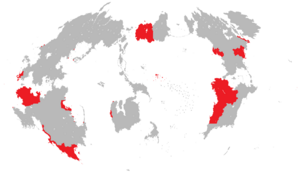
On the 23 Hunyo 1555, the Palon Empire was formed after the Mudon Charter was signed by Mudon II. The empire comprised of mainland Paloa and its colonies which had their own government bodies which included some indigenous representatives to prevent rebellion and unrest. In 1561, the Poder War erupted in South Domica after a naval incursion between the Atontec, Paqueon, and Palon Empire resulted in the Battle of Repent between the three empires on the 10 Phupu 1561. Although the war ended in a stalmate in 1562, the Treaty of Tavares which concluded the war saw the division of the continent between the three states.
During the war, the Palon South Aquamic Company was founded in Palon Aralona as one of at least a dozen trading companies. However, in 1569, a bill was passed by the Congress of Paloa making the CSA the only Palon trade company in the south Aquamic region. A conflict in 1572 against the Neragese known as the Coffee War saw the expulsion of the Neragese East Naphtora Company, the biggest rival of the CSA, leaving the CSA as the only trading company in the region and beginning the company's monopoly over Naphtoran coffee as well as tobacco and tea.
On 7 Phupu 1582, a skirmish occurred on the colonial border of Paqueonia and the Omaran Empire, starting the Flonesian War. Paloa later joined the war on the Omaran side with the creation of the Arbrim-Afonso Pact in Enero of 1583. The Palons were initally successful, being led by General Fredric Rego. However, on 13 Enero 1583, Rego started a campaign into Paqueon controlled Aralona with around 4,000 Omaran and 70,000 Palon soldiers. By 13 Memesa 1583, they reached Ironey and began to siege it. The siege lasted until the 2 Pusper when the Paqueons were driven out of the city. An estimated 90,000 soldiers died, making the siege one of the most deadilest in the war. Although the Rego won, he did not have the manpower to take control of the city and was forced to retreat after losing the Battle of Lake Cylon, ending the campaign in defeat.
From Memesa 1583 to Hunyo of 1584, Victor Catalá and Seronian general Jūsmiņš Osis invaded Omaran controlled territory in Aralona and succeeded in driving the bulk of the Omaran army of the island. Meanwhile, Paqueon forces under the command of Enrique Charpantier managed to successfully expel Palon forces off of Aralona by Enero of 1584. After hearing the news on the 20th of Enero, Fredric Rego gathered remnants of the Palon and Omaran army and begun to conduct guerilla warfare in the desert as well as the jungles of Aralona. Guerilla warfare ended in Tebax of 1586 with the dual surrender of Paloa and the Omaran in exchange for the return of remaining soldiers in Aralona, ending the war. The Nuevo Ahorrar Peace Conference which took place saw the end of an Omaran and Palon presence over the island and allowed Paqueonia and Seronia-Sotha to solidify their hold over Aralona with Sereno-Sothan dominance over the northern region of the continent, and a Paqueon presence in the south. Additionally, the war also saw the displacement of millions of native Flonesians and the near extinction of the Iolana Culture.
During the Great Enlightenment, Paloa was considered one of Oranland's "unenlightened" backwaters. At that time, it was a country of about 2.5 million in 1590. Deeply embarrassed, Márico Machado de Seabra, Prime Minister of Paloa assisted in reforming the education system in 1593. He created the basis for secular public primary and secondary schools, introduced vocational training, created hundreds of new teaching posts, added departments of mathematics and natural sciences to the University of Leitao, and introduced new taxes to pay for these reforms.
But Machado's greatest reforms were economic and financial, with the creation of several companies and guilds to regulate every commercial activity. He demarcated the region for production of wine, the first attempt to control wine quality and production in Oranland. He ruled with a strong hand by imposing strict laws upon all classes of Palon society from the nobility to the working class, and through his widespread review of the country's tax system. These reforms gained him enemies in the upper classes, especially among the high nobility, who despised him as a social upstart. The reform of the wine industry in 1608 provoked riots that were suppressed with considerable bloodshed. Machado would be assassinated in Kunnen of 1617, ending the First Palon Reformation.
Meanwhile, the War of 1602 begun between the Paqueon and Neragese Empire which later led to the involvement of 5 other main combatants: Seronia-Sotha, Paloa, the Omaran, Eudocia, and Zhao dynasty. Paloa joined the conflict nearing the end of the war in 1613 on the Neragese side. Under the leadership of General António Melo, the Palon army managed to reach Castelano, the capital of Paqueonia in Okjatab of 1614. However, they lost the Battle of Castelano forcing the two sides into a stalemate. After the war ended in Enero of 1615, the borders between the two nation did not change.
Brunoan Era
The Brunoan Era begun on 13 Marto 1633 with the coronation of King Bruno I, son of the late King Afonso V. The reign of Bruno I was a time of immense social change in Paloa, with the beginnings of the Second Palon Reformation which began the process of modernisation, and the emergence of rival political parties like the Verdes and Ideinov. In rural areas, it saw huge changes to the movement of people and the decline of small communities, the growth of the cities and the beginnings of an integrated transportation system but, nevertheless, as rural towns and villages declined and work became scarce there was a huge increase in emigration to Palon South Domica, and other parts of the Palon Empire.
Bruno I's reign ended in 1697 with his death. King Bruno II became king just 5 days later. Bruno II was a beloved monarch, a patron of fine art and music, and a proficient composer and writer on musical subjects. He is known for collected one of the largest libraries in the world. Abroad, the Serono-Sothans took over Palon Nullarica in Memesa of 1703 and the Palon South Aquamic Company ceased operation in the Aquamic Ocean region after losing the Companies' War in 1722. However, Paloa won the War of 1740 in 1743 allowing Paloa to assume control of the western half of the Trimeshian continent while Neragon took over the other half. Bruno II died in 1755 and was succeeded by his son Bruno III.
Bruno III became king when he was seventeen years old. The young king suffered from an illness that paralyzed the left side of his body and left him mentally unstable. After a two-year regency of X, the uncle of Bruno III, Bruno assumed the control of the country. However, his reign was short-lived as he contracted smallpox in 1757 and died shortly after in Phupu. His nephew Bruno IV succeeded him.
Bruno IV encouraged the focusing of Palon exploration of the South Domican interior after silver was found in Palon controlled territories of which he used to maintain a lavish court and ruled as an absolutist king, ignoring the Congress of Paloa (which had only convened sporadically since 1757) and personally appointing ministers. He is perhaps the best example of an absolutist monarch in Paloa. His long reign from 1757 to his death in 1818 (end of the Brunoan Era) was characterized by a strengthening of the king's powers, made possible by the large revenues flowing to Paloa from South Domica.
Succession Crisis and Peninsular War
Bruno IV died in 1818 without an heir which resulted in Congress rule from 1818 until Sebastião da Alves proclaimed himself king in 1823. During these five years, Paloa lost their colonies in South Domica to revolutionaries the most notable being the Walivian Revolution in 1819. By the end of the Amplan Wars in 1826, all Palon colonies had gained independence.

on 18 Tebax 1823, Sebastião da Alves, an uncle of the late Bruno IV, with an army of supporters marched to the royal palace in Leitao and proclaimed himself king. His proclaimation was met with protest especially from Pedro III of Paqueonia, a cousin of Bruno. This ultimately led to a succession crisis between the two claimants which ended on 15 Pulungana when Paqueon forces crossed the border into Paloa and the Battle of Salgado took place, sparking the War of Palon Succession. The war ended 4 Memesa 1825 with the Treaty of Salgado which saw the Paqueon annexation of Paloa and the exile of Sebastião to New Roque where he died of a stroke in 1831.
for the duration of Paqueon rule over Paloa from 1825 to 1828, numerous uprisings would occur throughout the region the last of which (most successful) in 1828 was called simply the Palon Rebellion. They rose up in Leitao on 20 Gunyana. On the 20th of Okjatab, Paloa and Cavala forged an alliance during the Brumeux Conference entering Cavala into the war against Paqueonia. The Paqueons held the advantage in the early stages, but were forced onto the defensive after 1829 Battle of Pinta. Cavala's invasion of Paqueonia was led by General Jean Forgeron and in Disemba of 1829 launched a campaign to reach Castelano. He scored major victories such as the Battle of Muerte, and Ifiere. Paqueonia's capital of Castelano fell on the 12th of Tebax 1830 after a month long siege. The Treaty of Hidalgo on 17 Tebax saw majorly the independence of Paloa and some minor border changes between Cavala and Paqueonia.
The death of Bruno IV is regarded by historians as the end of the "First" Palon Empire and the end of the Peninsular War as the beginning of the "Second" Palon Empire.
Isabellan Era
TBA
Franciscan Era
TBA
Contemporary Age
TBA
Geography
The territory of Paloa consists of an area on the Hesterlon Peninsula sometimes referred to as the mainland by most Palon people, and an island and archipelago in the Ingentric Ocean: the island of Farata and the archipelago of New Roque. Paloa has a total land area of 360,087.9 km2 (139,030.7 sq mi) making it the X largest in Oranland and the X in Gentu.
Mainland Paloa is split by its 2 main river, the Leitao River and the Alemán, both of which flows from X and disgorges into their own respective estuaries, before escaping into the Ingentric. The northern landscape is mountainous towards the exterior with large plains towards the interior, the central landscape meanwhile consists of a mixture of flat plains and rolling hills, whereas the south, including the islands and archipelago region, is characterized by rolling plains with a few mountain ranges dotted about the region. Paloa's highest peak is Mount Subir in the Surmonté mountains which measures 897 m (2,942.9 ft) while to lowest point is the Afundar Depression which sits at 104 m (341 ft) below sea level on the Afundar Peninsula in central Paloa. The island and archipelago of Farata and New Roque are scattered within the Ingentric Ocean: Farata as well as New Roque is situated along a range formed by in-plate hotspot geology. Geologically, these islands were formed by volcanic and seismic events. The last terrestrial volcanic eruption occurred in 1848 (Matarmorrer) and minor earthquakes occur sporadically, usually of low intensity.
Paloa's territorial waters, a sea zone over which Paloa have special rights over the exploration and use of marine resources, has 3,776,946 km2. This is the X largest territorial waters of Oranland and the X largest in Gentu.
Climate
The Climate of Paloa is characterised by an oceanic climate to the north and central region, and a Zestoric climate in the south and in Farata and the New Roque archipelago.
TBA
Environment
TBA
Administrative divisions
TBA
Major cities
TBA
Politics and government
TBA
Military
TBA
Foreign relations
TBA
Economy
TBA
Tourism
TBA
Energy
TBA
Industry
TBA
Infrastructure
TBA
Transport
TBA
Science and technology
TBA
Demographics
The Palon Ministry of Statistics estimates that, according to the 1999 census, the population was 34,926,602 (of which 37% was female, 63% was male). 65.3% of the population is identified as Palon; 21.4% are Hestandan, heavily concentrated in the eastern region of the country; 9.7% of the population are Azoran; while the remaining 3.6% identifies as Qiuese, Neragese etc. In terms of religious belief, as of 2000, 89.2% answered as a part of Terranity with 64.1% (of the total population) identifying as an Altenic and 24.9% as Paxist, 9.5% answered with no religion while 1.3% had other beliefs such as Plecanism and Kaoism. The Palon language is the official language of Paloa with Hestandan as a recognised regional languages in some subdivisions of the eastern region.
Paloa has a population density of 96.9/km2 (251.0/sq mi). Being a developed country, Paloa has a life expectancy of around 82.75 years. Palo additionally has a very low infant mortality rate of 1.4 boys and 1.7 girls per 1,000 births. Historically the rate of reproduction remained above-average with 1.3 children in the mid 1900s, but deteriorated significantly since then with a period of the death rate of Paloa exceeding its birth rate and a slightly shrinking population between 1950 and 1970. The fertility rate of Paloa as of 1995 was estimated at 1.92 children born/woman, the Xth in Gentu, it remains considerably below the high of 5.02 children born per woman in 1899. In 1996, 65.2% of births were to unmarried women. Like most Oranish countries, Paloa has to deal with low fertility levels: the country has experienced a sub-replacement fertility rate since the 1960s. Paloa subsequently has the Xth oldest population in the world, with the average age of 44.6 years.
Paloa's congress has approved a budget plan in 1993 for 1994 that includes tax breaks for emigrants that have recently emigrated to Paloa. The expansionary 1994 budget, backed by a left-wing majority in congress, also aims to boost the purchasing power of households while cutting the already low deficit even further. Emigrants will also be allowed to declare only half their taxable income for five years, provided they lived abroad for at least three years. The programme is to run for two years. Emigrants returning in 1998 and 1999 will see their taxes halved as part of the stimulus to bring emigrants to Paloa and revitalize the population and promote continued economic growth – as Paloa struggles with a low birth rate and an ageing population. According to projections by the Ministry of Statistics, Paloa's population will fall to 32.1 million by 2020 from 34.9 million now if the trend continues and the population will continue to age.
Language
TBA
Major cities
TBA
Education
TBA
Magic
TBA
Religion
According to the 1999 Census, 89.2% of the Palon population was Terranist with 64.1% identifying as Altenic and 24.9% as Paxist, 1.3% consists of other beliefs such as Plecanism, Kaoism, and Hafan. Influences from Naphtoran Traditional Religion and Native Domican Traditional Religion are also felt among many people, particularly in fields related with Traditional Domican Medicine and Traditional Naphtoran Herbal Medicine. Some 4.6% identifies to have no religion, and 4.9% did not give any answer about their religion. Many Palon holidays, festivals and traditions have a Oranish origin or connotation.
The growth of the Palon Empire made its missionaries important agents of colonization, with important roles in the education and conversion of people from all the inhabited continents. The growth of liberal and nascent republican movements during the eras leading to the formation of the Republic of Paloa in 1957 changed the role and importance of organized religion. Paloa is a secular state, the Palon constitution guarantees freedom of religion as an individual constitutional right. Thus the religious view of the state is determined to be neutral and the right of self-determination for religious groups upheld. While the government refrains from recognizing any certain rights of a religious group, and these groups are expected to reject any interaction with politics.
Culture
TBA
Music and art
TBA
Fashion
TBA
Philosophy
TBA
Literature
TBA
Architecture
TBA
Cuisine
TBA
Sports
TBA
Media
TBA



